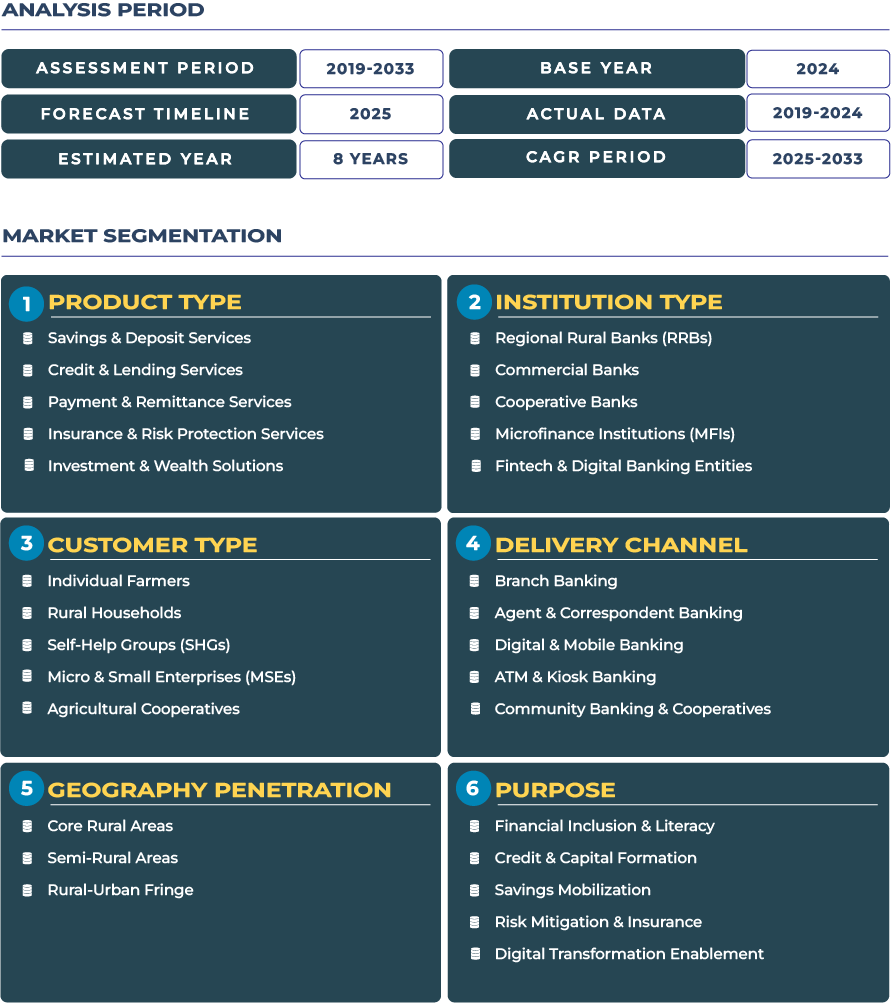Kuwait Rural Banking Outlook: Channeling Rural Capital Abroad Through Farmland Investment Finance
Kuwait rural banking market stands as a unique ecosystem shaped by a limited domestic agricultural base but a strong overseas investment footprint. Rather than expanding traditional domestic rural banking channels, Kuwait has redirected its capital into structured overseas farmland finance and controlled-environment (CE) agriculture investments. This strategy aligns with the country’s sovereign wealth and food security priorities under the Central Statistical Bureau and broader diversification initiatives promoted by the Central Bank of Kuwait.
Note:* The market size refers to the total fees/revenue generated by banks through various services.
As of 2025, the Kuwait rural banking market is valued at USD 1.4 billion and is projected to reach USD 1.8 billion by 2033, expanding at a moderate CAGR of 3.5% during 2025–2033. Despite modest domestic opportunities, the sector’s growth is largely sustained by cross-border agricultural finance, sovereign investment funds, and family-office-driven agri-asset allocations. Kuwait’s rural banking institutions increasingly deploy capital in farmland-backed lending, agri-insurance services, and commodity-linked credit to support sustainable food systems abroad, thereby transforming rural finance into a tool of global strategic influence.
Driving Forces Behind Kuwait’s Rural Banking Expansion: Overseas Agri-Investment and Family-Office Capitalization
The primary growth catalyst in Kuwait rural banking sector stems from the nation’s strategic redirection of wealth into overseas agricultural investments. Given the geographical limitations of domestic arable land, Kuwaiti financial institutions and family offices have turned toward structured farmland acquisition finance and agri-investment syndicates in Africa, Eastern Europe, and Southeast Asia. These investment routes are designed not only to secure food supply chains but also to create stable income channels through agricultural commodity returns.
Another major driver is the rise of sovereign-backed agriculture funds managed through the Kuwait Investment Authority, which integrates farmland financing with strategic partnerships and bilateral trade initiatives. Kuwaiti banks are increasingly offering tailored credit and lending services linked to export-import mechanisms that mitigate food import dependency. Furthermore, the sector benefits from the government’s push for sustainable investment frameworks aligned with national food resilience policies. This growing synergy between public capital and private agri-finance institutions continues to shape the nation rural banking market toward international financial integration.
Structural Barriers and Local Constraints in Kuwait Rural Banking Ecosystem
Despite promising international ventures, Kuwait rural banking industry faces intrinsic structural barriers within its domestic landscape. The country’s limited rural population and low agricultural productivity constrain opportunities for local lending and insurance penetration. The reliance on import-oriented food supply chains further reduces demand for traditional rural banking products such as micro-lending and local farm insurance.
Another challenge lies in balancing overseas capital exposure with domestic liquidity management. Kuwait’s banks, while efficient in asset allocation abroad, often face pressure from volatile global commodity markets and geopolitical tensions affecting farmland-based assets. Additionally, regional climate stress and water scarcity make it challenging to promote sustainable rural credit schemes within the country. These constraints underscore the need for diversified financial innovation that connects rural financing to Kuwait’s sustainability and food security vision, without overreliance on external farmland projects.
Emerging Trends: Cross-Border Farmland Structuring and the Rise of Sustainable Agri-Finance
A defining trend in Kuwait’s rural banking evolution is the sophistication of cross-border farmland investment structures. Kuwaiti investors, in collaboration with regional and European financial intermediaries, are creating mezzanine and asset-backed financing frameworks that link farmland acquisition to output-based returns. For example, Kuwaiti family offices are now exploring mezzanine financing structures for CE agriculture facilities abroad, ensuring predictable yield through guaranteed offtake contracts with global food distributors.
Moreover, the sector is witnessing an uptrend in agri-insurance and risk protection services, particularly as investors seek to mitigate climate and political risks in overseas territories. Wealth management divisions of local banks are also introducing investment and wealth solutions tailored for farmland-linked securities, broadening access for institutional and high-net-worth investors. These trends signify Kuwait’s shift from traditional banking to a more globally networked model of rural financial management anchored in sustainability and diversification.
Strategic Opportunities: Expanding Rural Finance Through Agri-Fiat and Mezzanine Instruments
The next decade presents Kuwait with a remarkable opportunity to deepen its influence in global agriculture through innovative rural finance mechanisms. Fiat-finance structures for overseas farmland acquisition are expected to gain traction, enabling Kuwaiti banks to offer hedged credit lines in collaboration with international institutions. Similarly, mezzanine finance for CE agriculture projects presents a compelling avenue, balancing yield generation with moderate risk exposure.
Domestic regulatory alignment led by the Central Bank of Kuwait is also expected to accelerate the integration of ESG-compliant frameworks in agri-finance. This shift will likely enhance investor confidence, encourage sustainable overseas farmland ventures, and open up new channels for Islamic finance participation in the global rural banking ecosystem.
Competitive Landscape: Mezzanine Funds, Family-Office Agri Investments, and Institutional Finance
The Kuwait rural banking sector is increasingly characterized by hybrid financial innovation driven by domestic banks and private investment entities. Local banking leaders such as Finance House and National Bank of Kuwait are adopting blended finance approaches combining Islamic principles with agri-linked lending solutions. Their focus on aligning commercial returns with sustainability objectives underscores the competitive evolution of Kuwait rural banking market. These developments position Kuwait not merely as a domestic banking hub, but as an influential cross-border player in global rural finance.







